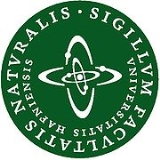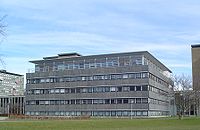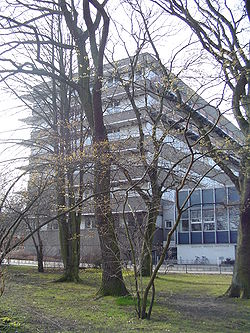
University of Copenhagen Faculty of Science
Encyclopedia
The Faculty of Science (Det naturvidenskabelige fakultet in Danish) at the University of Copenhagen
consists of both mathematical and natural sciences, and is divided into 11 institutes including the Natural History Museum of Denmark. Some institutes are in turn divided into a number of sections and laboratories, and the faculty also encompasses several national and international research centres, and has a number of field stations in Denmark
and in Greenland
, among them the Arctic Station in central West Greenland.
All institutes are situated in the central part of Copenhagen
. The fine old building of the former Astronomical Observatory - 3 Øster Voldgade - now houses the Faculty Administration.
The Faculty of Science is a big and living work place. The faculty has a permanent staff of 1200 people inclusive academic tenures and technical or administrative personnel. Additionally a large number of temporary staff works at the faculty financed by external grants and contracts.
The Faculty of Science offers a three-year Bachelor of Science degree
(BS), a two-year Master of Science degree
(MS) and a three-year Ph.D.
degree. There are two main areas of study programmes. One is the mathematical-physical-chemical subject group, which includes mathematics
, computer science
, actuarial science
, mathematical economy
, statistics
, physics
, astronomy
, geophysics
, meteorology
, biophysics
, chemistry
, environmental chemistry
, biochemistry
and nano-science
. The other is the natural history-geography group, which includes biology
, sports science, geology
, geography
, geo-informatics, geology-geophysics and bio-informatics. From September 2003 the Faculty of Science additionally offers 2 one-year master programmes, one in Geography and one in Physical Education and Sports Science.
In 2002 the faculty had a total of 6200 ordinary students enrolled together with a large number of guest students from universities abroad or other institutions in Denmark. The number of students in each programme varies significantly, whereas 1350 students are enrolled in the Biology
programme, a total of 124 students is enrolled in the Actuarial Mathematics programme.
which is written in a circle around a stilized rendering of a hafnium
atom. Hafnium was discovered at the Faculty in 1923 by Dirk Coster
and Georg von Hevesy, and the name of the element is derived from Hafnia which is the Latin name for Copenhagen
.


On January 1, 2004, the Botanical Institute and Zoological Institute merged together as Department of Biology, while the four museums Botanical Garden
, Botanical Museum and Library, Geological Museum and Zoological Museum
merged together as Natural History Museum of Denmark.
On January 1, 2005, the August Krogh Institute
and the Department of Molecular Biology merged together as Department of Molecular Biology and Physiology.
On January 1, 2008, the Department of Biology and the Department of Molecular Biology and Physiology merged together as a reconstructed Department of Biology.
University of Copenhagen
The University of Copenhagen is the oldest and largest university and research institution in Denmark. Founded in 1479, it has more than 37,000 students, the majority of whom are female , and more than 7,000 employees. The university has several campuses located in and around Copenhagen, with the...
consists of both mathematical and natural sciences, and is divided into 11 institutes including the Natural History Museum of Denmark. Some institutes are in turn divided into a number of sections and laboratories, and the faculty also encompasses several national and international research centres, and has a number of field stations in Denmark
Denmark
Denmark is a Scandinavian country in Northern Europe. The countries of Denmark and Greenland, as well as the Faroe Islands, constitute the Kingdom of Denmark . It is the southernmost of the Nordic countries, southwest of Sweden and south of Norway, and bordered to the south by Germany. Denmark...
and in Greenland
Greenland
Greenland is an autonomous country within the Kingdom of Denmark, located between the Arctic and Atlantic Oceans, east of the Canadian Arctic Archipelago. Though physiographically a part of the continent of North America, Greenland has been politically and culturally associated with Europe for...
, among them the Arctic Station in central West Greenland.
All institutes are situated in the central part of Copenhagen
Copenhagen
Copenhagen is the capital and largest city of Denmark, with an urban population of 1,199,224 and a metropolitan population of 1,930,260 . With the completion of the transnational Øresund Bridge in 2000, Copenhagen has become the centre of the increasingly integrating Øresund Region...
. The fine old building of the former Astronomical Observatory - 3 Øster Voldgade - now houses the Faculty Administration.
The Faculty of Science is a big and living work place. The faculty has a permanent staff of 1200 people inclusive academic tenures and technical or administrative personnel. Additionally a large number of temporary staff works at the faculty financed by external grants and contracts.
The Faculty of Science offers a three-year Bachelor of Science degree
Bachelor's degree
A bachelor's degree is usually an academic degree awarded for an undergraduate course or major that generally lasts for three or four years, but can range anywhere from two to six years depending on the region of the world...
(BS), a two-year Master of Science degree
Master's degree
A master's is an academic degree granted to individuals who have undergone study demonstrating a mastery or high-order overview of a specific field of study or area of professional practice...
(MS) and a three-year Ph.D.
Doctor of Philosophy
Doctor of Philosophy, abbreviated as Ph.D., PhD, D.Phil., or DPhil , in English-speaking countries, is a postgraduate academic degree awarded by universities...
degree. There are two main areas of study programmes. One is the mathematical-physical-chemical subject group, which includes mathematics
Mathematics
Mathematics is the study of quantity, space, structure, and change. Mathematicians seek out patterns and formulate new conjectures. Mathematicians resolve the truth or falsity of conjectures by mathematical proofs, which are arguments sufficient to convince other mathematicians of their validity...
, computer science
Computer science
Computer science or computing science is the study of the theoretical foundations of information and computation and of practical techniques for their implementation and application in computer systems...
, actuarial science
Actuarial science
Actuarial science is the discipline that applies mathematical and statistical methods to assess risk in the insurance and finance industries. Actuaries are professionals who are qualified in this field through education and experience...
, mathematical economy
Economics
Economics is the social science that analyzes the production, distribution, and consumption of goods and services. The term economics comes from the Ancient Greek from + , hence "rules of the house"...
, statistics
Statistics
Statistics is the study of the collection, organization, analysis, and interpretation of data. It deals with all aspects of this, including the planning of data collection in terms of the design of surveys and experiments....
, physics
Physics
Physics is a natural science that involves the study of matter and its motion through spacetime, along with related concepts such as energy and force. More broadly, it is the general analysis of nature, conducted in order to understand how the universe behaves.Physics is one of the oldest academic...
, astronomy
Astronomy
Astronomy is a natural science that deals with the study of celestial objects and phenomena that originate outside the atmosphere of Earth...
, geophysics
Geophysics
Geophysics is the physics of the Earth and its environment in space; also the study of the Earth using quantitative physical methods. The term geophysics sometimes refers only to the geological applications: Earth's shape; its gravitational and magnetic fields; its internal structure and...
, meteorology
Meteorology
Meteorology is the interdisciplinary scientific study of the atmosphere. Studies in the field stretch back millennia, though significant progress in meteorology did not occur until the 18th century. The 19th century saw breakthroughs occur after observing networks developed across several countries...
, biophysics
Biophysics
Biophysics is an interdisciplinary science that uses the methods of physical science to study biological systems. Studies included under the branches of biophysics span all levels of biological organization, from the molecular scale to whole organisms and ecosystems...
, chemistry
Chemistry
Chemistry is the science of matter, especially its chemical reactions, but also its composition, structure and properties. Chemistry is concerned with atoms and their interactions with other atoms, and particularly with the properties of chemical bonds....
, environmental chemistry
Environmental chemistry
Environmental chemistry is the scientific study of the chemical and biochemical phenomena that occur in natural places. It should not be confused with green chemistry, which seeks to reduce potential pollution at its source...
, biochemistry
Biochemistry
Biochemistry, sometimes called biological chemistry, is the study of chemical processes in living organisms, including, but not limited to, living matter. Biochemistry governs all living organisms and living processes...
and nano-science
Nanotechnology
Nanotechnology is the study of manipulating matter on an atomic and molecular scale. Generally, nanotechnology deals with developing materials, devices, or other structures possessing at least one dimension sized from 1 to 100 nanometres...
. The other is the natural history-geography group, which includes biology
Biology
Biology is a natural science concerned with the study of life and living organisms, including their structure, function, growth, origin, evolution, distribution, and taxonomy. Biology is a vast subject containing many subdivisions, topics, and disciplines...
, sports science, geology
Geology
Geology is the science comprising the study of solid Earth, the rocks of which it is composed, and the processes by which it evolves. Geology gives insight into the history of the Earth, as it provides the primary evidence for plate tectonics, the evolutionary history of life, and past climates...
, geography
Geography
Geography is the science that studies the lands, features, inhabitants, and phenomena of Earth. A literal translation would be "to describe or write about the Earth". The first person to use the word "geography" was Eratosthenes...
, geo-informatics, geology-geophysics and bio-informatics. From September 2003 the Faculty of Science additionally offers 2 one-year master programmes, one in Geography and one in Physical Education and Sports Science.
In 2002 the faculty had a total of 6200 ordinary students enrolled together with a large number of guest students from universities abroad or other institutions in Denmark. The number of students in each programme varies significantly, whereas 1350 students are enrolled in the Biology
Biology
Biology is a natural science concerned with the study of life and living organisms, including their structure, function, growth, origin, evolution, distribution, and taxonomy. Biology is a vast subject containing many subdivisions, topics, and disciplines...
programme, a total of 124 students is enrolled in the Actuarial Mathematics programme.
The seal
The seal of the faculty contains the following text
|
|
which is written in a circle around a stilized rendering of a hafnium
Hafnium
Hafnium is a chemical element with the symbol Hf and atomic number 72. A lustrous, silvery gray, tetravalent transition metal, hafnium chemically resembles zirconium and is found in zirconium minerals. Its existence was predicted by Dmitri Mendeleev in 1869. Hafnium was the penultimate stable...
atom. Hafnium was discovered at the Faculty in 1923 by Dirk Coster
Dirk Coster
Dirk Coster , was a Dutch physicist. He was a Professor of Physics and Meteorology at the University of Groningen....
and Georg von Hevesy, and the name of the element is derived from Hafnia which is the Latin name for Copenhagen
Copenhagen
Copenhagen is the capital and largest city of Denmark, with an urban population of 1,199,224 and a metropolitan population of 1,930,260 . With the completion of the transnational Øresund Bridge in 2000, Copenhagen has become the centre of the increasingly integrating Øresund Region...
.
Departments under The Faculty of Science


- Department of Biology
- Department of ChemistryUniversity of Copenhagen Department of ChemistryResearch and education in chemistry has been conducted at the University of Copenhagen Department of Chemistry since 1778, when the first Laboratorium Chymicum was established. Since then, the chemists have moved several times, usually to better surroundings. In 1962, Universitetets Kemiske...
- Department of Computer Science
- University of Copenhagen Department of Geography & Geology
- Institute for Mathematical SciencesUniversity of Copenhagen Institute for Mathematical SciencesThe Department of Mathematical Sciences is an institute under the Faculty of Science at the University of Copenhagen.The department is located in the E building of the Hans Christian Ørsted Institute, on Universitetsparken 5 in Copenhagen, Denmark....
- Institute of Molecular Biology and Physiology
- Niels Bohr Institute for Astronomy, Physics and Geophysics
- Institute of Exercise and Sport SciencesUniversity of Copenhagen Institute of Exercise and Sport SciencesThe Institute of Exercise and Sport Sciences was established in September 1997 through the consolidation of the former Laboratory for Human Physiology, the August Krogh Institute, and the Centre for Sports Research , all parts of the University of Copenhagen, and the formerly independent Danish...
- Department of Science Education
- Natural History Museum of Denmark
- Bioinformatics CentreBioinformatics CentreThe Bioinformatics Center conducts interdisciplinary research in bioinformatics and is in charge of a masters program in bioinformatics. The center is affiliated with the Institute of Molecular Biology within the Faculty of Science of the University of Copenhagen.The center is headed by Anders...
- Center for the Philosophy of Nature and Science Studies (CPNSS)Center for the Philosophy of Nature and Science Studies (CPNSS)The Centre for the Philosophy of Nature and Science Studies involves a small group of scientists, philosophers of science, and researchers engaged in the interdisciplinary field denominated here as the philosophy of nature and science studies, including history, philosophy and sociology of science...
- Center for Planetary ResearchCenter for Planetary ResearchThe Center for Planetary Science at the University of Copenhagen was created in February 2001 when the planetary science groups from NBIfAFG and DSRI were merged. Together with associated national and international groups it aims to strengthen planetary research in Denmark and to provide a...
- Center for Social Evolution and Symbiosis
- COGCI - Copenhagen Global Change Initiative
- Danish Archaea Centre (DAC)
- Nano-Science Center
- Natural Sciences IT Competence Center
- Arctic Station
On January 1, 2004, the Botanical Institute and Zoological Institute merged together as Department of Biology, while the four museums Botanical Garden
University of Copenhagen Botanical Garden
The University of Copenhagen Botanical Garden , usually referred to simply as Copenhagen Botanical Garden, is a botanical garden located in the centre of Copenhagen, Denmark...
, Botanical Museum and Library, Geological Museum and Zoological Museum
University of Copenhagen Zoological Museum
The Copenhagen Zoological Museum is a part of the Natural History Museum of Denmark which consist of four natural science museums.The permanent exhibition 'From pole to pole' show animals from around the world in big displays...
merged together as Natural History Museum of Denmark.
On January 1, 2005, the August Krogh Institute
August Krogh Institute
The August Krogh Institute is part of the Faculty of Science at the University of Copenhagen. The primary research areas include physiology and biochemistry, while the educational efforts are concentrated on biology....
and the Department of Molecular Biology merged together as Department of Molecular Biology and Physiology.
On January 1, 2008, the Department of Biology and the Department of Molecular Biology and Physiology merged together as a reconstructed Department of Biology.

